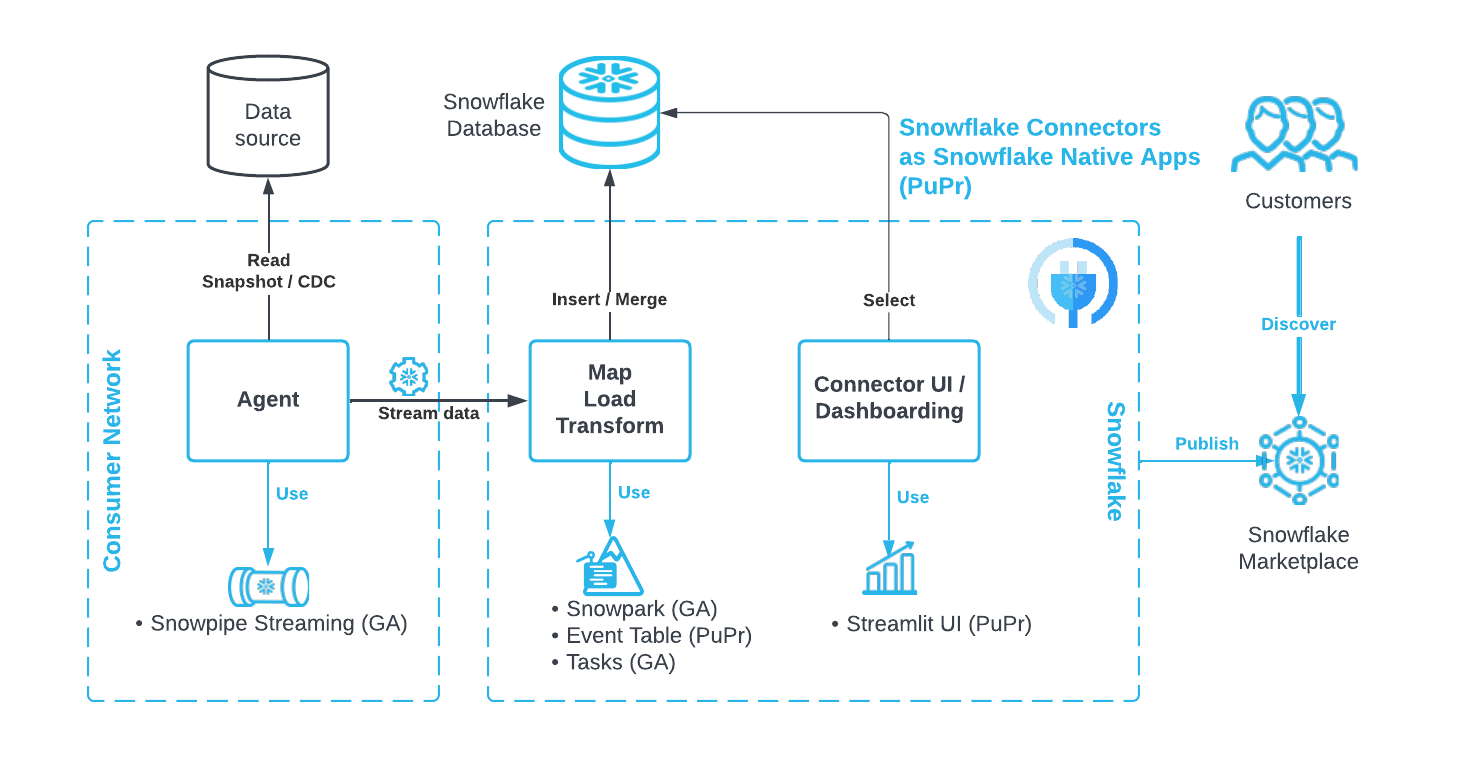Snowflake Native SDK for Connectors¶
The Snowflake Native SDK for Connectors is a library that provides a skeleton of the Snowflake native app whose purpose is to ingest data from external data source into Snowflake. We call such an app a native connector.
The Snowflake Native SDK for Connectors is a set of application examples, templates, and tutorials which show how to build, deploy, configure, and use a Snowflake Native App that ingests data from an external data source into Snowflake. These resources cover both pull-based and push-based data integration patterns.
These templates do not restrict or limit developers. Instead, the templates provide examples of how to use core Snowflake features to ingest data and encapsulate application code within a Snowflake Native App.
The Snowflake Native App Framework allows providers to publish and monetize a Snowflake Native App on the Snowflake Marketplace. Snowflake Native App developers can clone the template repository, modify the boilerplate code, and create their own Snowflake Connectors.
What is a native connector?¶
A connector is an application that allows data flow from an external source system into Snowflake. A native connector is a connector application built and deployed using the Snowflake Native App Framework. There are different types of connectors:
pull-based connectors
push-based connectors
The Snowflake Native SDK for Connectors currently supports only the pull-based pattern.
Pull-based connectors¶
Pull-based patterns are effective when the source data provider does not manage customer data in Snowflake and is not willing to incur COGS for a continuous data share in Snowflake. These patterns are also effective when a source data provider has well-documented APIs that customers can use to replicate and consume data.
How to use a pull-based pattern¶
By using a pull-based connector pattern, providers (Snowflake, or a third-party ETL provider) can publish and distribute a native connector based on a Snowflake Native App using the Snowflake Marketplace. A native connector uses direct external access to connect with the source application. It performs outbound authentication, fetches data from the source directly into a customer’s Snowflake account, processes and persists the data based on a user-specified configuration.

Push-based connectors¶
Using a push-based pattern is effective when inbound access to the source application through a customer firewall is not feasible because of security, performance or governance limitations. This pattern uses an agent and a Snowflake Native App to allow customers to ingest data changes into Snowflake from behind a firewall .
How to use a push-based pattern¶
An agent is a standalone application, distributed as a Docker image, that is deployed in a customer environment and is responsible for sending initial and incremental loads to Snowflake by reading data changes from a source CDC stream.
A Snowflake Native App runs within Snowflake and coordinates the integration. It is primarily responsible for managing the replication process, controlling the agent state and creating required objects, including the target databases.

What is the native SDK for connectors?¶
The Snowflake Native SDK for Connectors is a library that provides universal components that can be used to build a custom Snowflake native app that ingests the data from an external data source into Snowflake. The provided components define the recommended flow
of the connector application and allow for customization and exclusion of some features. As of now the Snowflake Native SDK for Connectors is provided as code to be built locally and only in Java. Additionally, a second library containing useful helper and utility classes for writing unit tests is provided. Those libraries can be found in the maven central repository:
The provided examples using those libraries also include example scripts that can be used to deploy and create instance of the application inside Snowflake.
The Snowflake Native SDK for Connectors is designed to be used when building applications based on the Snowflake Native App Framework and then publish and monetize them using Snowflake Marketplace. To use the Snowflake Native SDK for Connectors, clone it from a template or example application.
The Snowflake Native SDK for Connectors leverages the following features of Snowflake:
Additional information¶
For more information about the Snowflake Native SDK for Connectors, examples, template, and tutorials see:
Learn more¶
For more information about implementing connectors, see Getting started with the Snowflake Native SDK for Connectors